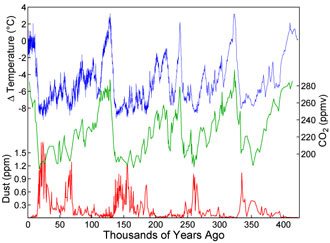Would one think that this implicates insolation in some way?

Would one think that this implicates insolation in some way?

Intriguing you should note this. From what I've read, the cold glacial periods were definitely dustier, but probably not enough so to affect insolation. Rather (this is the fun part) the higher dust levels put more iron in the oceans, increasing ocean primary productivity, which increases the air-sea CO2 flux, and thus helps to maintain the low atmospheric CO2 concentrations of the glacial period. As I've noted (profile has supporting material), the climate system needs to shift from glacial conditions to interglacial conditions; the shift trigger appears to be the rapidly changing insolation that occurs at Milankovitch cycle minima and maxima.